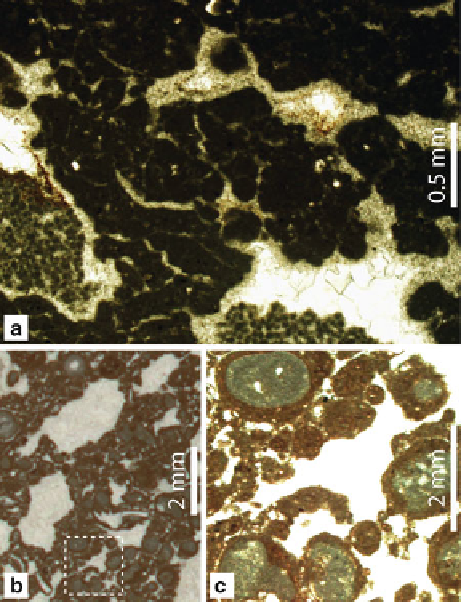Geology Reference
In-Depth Information
Fig. 21.14
(
a
,
b
,
c
) Subaerial exposure features in intertidal
fenestral grainstone from the Upper Jurassic Mozduran
Formation in the Kopet Dagh back arc basin, northeast Iran:
(
a
) Photomicrograph under normal light of a fenestral peloidal
intraclast grainstone. Note that the geopetal sediment (silt-sized
peloids) overlies earlier
light brown
vadose cement and is over-
lain by late stage phreatic drusy mosaic cement. (
b
-
c
) Thin sec-
tion photograph of fenestral grainstone facies showing subaerial
exposure features. Photograph (
c
) is the enlarged portion of the
lower part
of (
b
) showing partial dissolution of the grains,
enlarged pores and formation of iron oxide stained coated
grains
soil horizon without any intervening tidal fl at facies as
a result of rapid sea level fall and prolonged exposure
(Hardie
1986
; Preto et al.
2004
) . Examples include the
karstic soil-capped cycles of the Plio-Pleistocene
deposits of the Bahamas (Beach and Ginsburg
1980
)
and the calichie-capped tepee dominated diagenetic
cycles of the Middle Triassic Latemar Limestone of
northern Italy (Hardie et al.
1986
) formed under humid
and arid- to semiarid conditions, respectively. The meter-
scale peritidal cycles are known as parasequences
(e.g., Van Wagoner et al.
1988
; Lehrmann and
Goldhammer
1999
; Burgess
2006
; Spence and Tucker
Fig. 21.15
(
a
,
b
) Photomicrographs of calcite cemented fenes-
tral fabric (birdseyes) in lime mudstone interpreted as supratidal
facies. Note the calcite-cemented root casts and small birdseyes
in b; Cave Hill Member of the Mississippian Kinkaid Formation,
southern Illinois. (
c
) Photomicrograph of the lowermost inter-
tidal calcite-cemented fenestral peloid intraclast grainstone
under plane-polarized light showing early vadose cement (
light
yellowish brown crystals
) that lines the larger fenestrae and fi lls
the smaller voids. Note that the vadose cement is overlain by
later phreatic cement indicating subaerial exposure; Upper
Jurassic Mozduran Formation in the Kopet Dagh back arc basin,
northeast Iran


